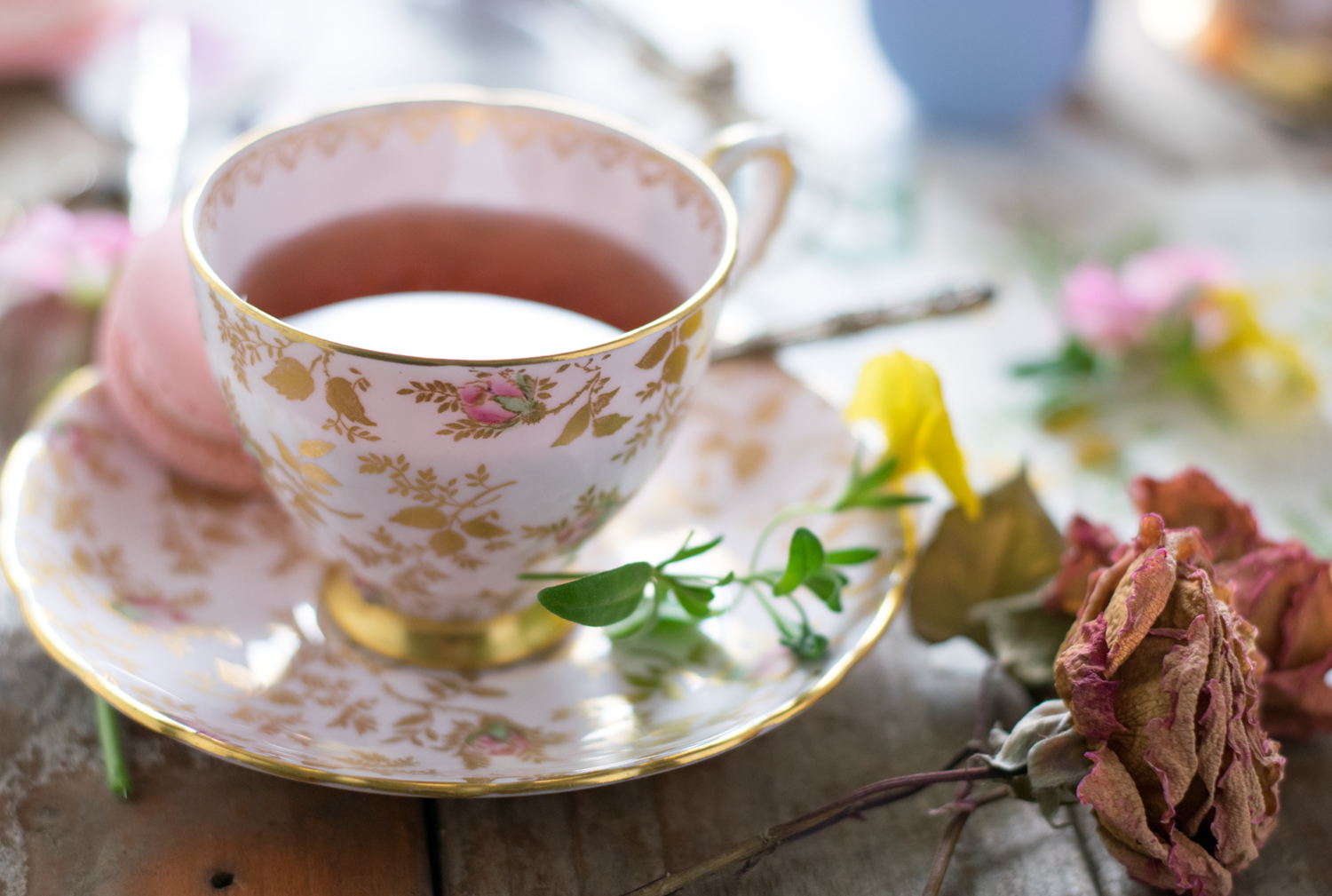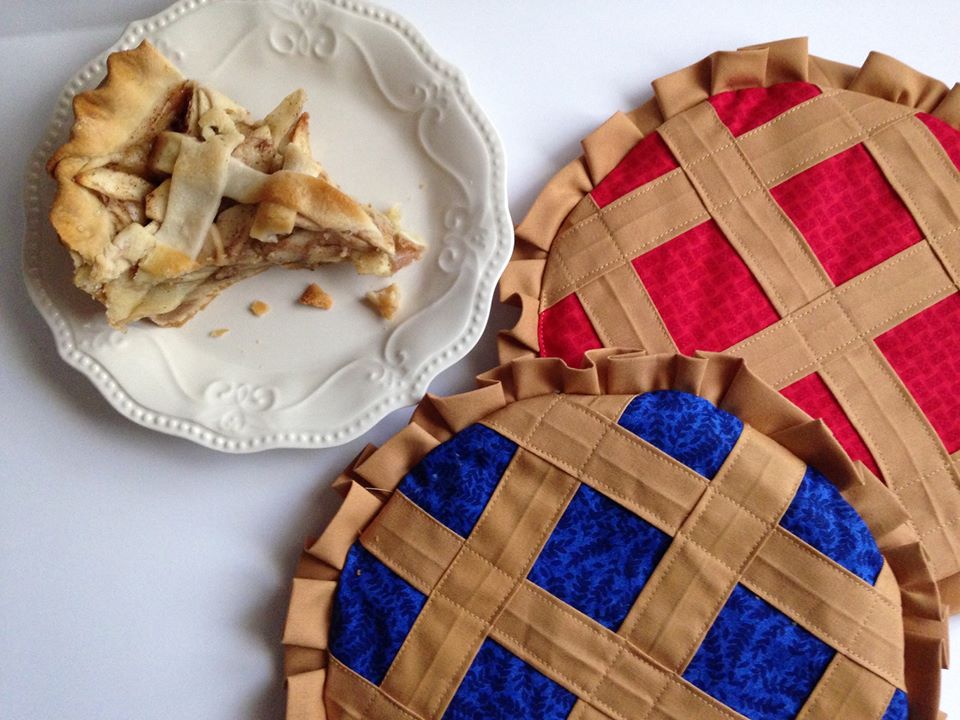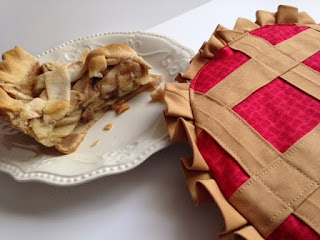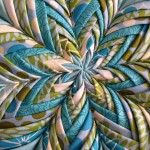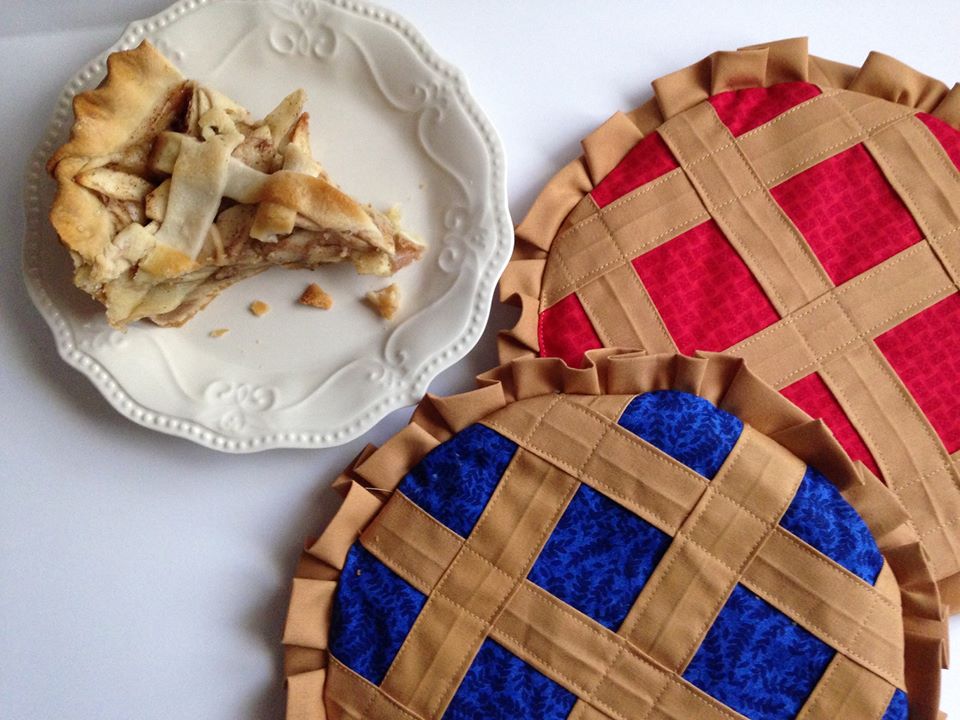
The other day, I really enjoyed making the Folded Star Tutorial for you guys (see that here). Sewing, for me, is a definite seasonal activity– I start to itch to do it when fall rolls around and the weather gets cooler.
Yet, this is a baking blog.
Ugh. I want to sew and I want to bake. What’s a girl to do! How about sew some baking projects? Oh, yeah. That sounds like a perfect match.
So what are we waiting for? Let’s do this!
Today, we are going to make some adorable Cherry and Blueberry pie potholders. You can make any kind of “pie” that you like– heck– make it purple, if you want to. I won’t judge.
To start, you need some tan fabric for the crust and some colored fabric for the pie. I’m not sure exactly how much I used, since I tend to pull from my scrap pile. I do know that it took more tan than I expected– the crust takes more material than you would think.
You also need a ruler, a rotary cutter, and a round template– this is just an old piece of cardboard. You can trace around a salad plate to make your cardboard template if you want a perfect circle.
First, we need to prepare our pieces. We are going to start with the lattice crust. Draw several lines on the tan fabric that are 2″ wide. I have this handy dandy little ruler that is exactly 2″ wide, in addition to being clear and see-through, so I can see the layers underneath, so I traced around that. I used roughly 1 yard (maybe a touch more) of this 2″ piece for my lattice work. I’ll show you show to do it, in a second. Don’t go crazy– just cut a little bit, and if you need more, later, you can cut a little more. I hate having tons of extra snips that I can’t use, when my project is over.
Iron your 2″ lattice this way– first, iron the strip perfectly in half. Then, flip it open and bend the sides back so that they touch in the center. Iron your entire strip this way.
Now, we are going to make some bias binding for the crust. If you’ve ever heard the term “bias binding,” and you know anything about quilting, the term has, at one time or another, probably struck terror into your heart. I think that every quilter, experienced or novice, has, at one time, thought about the process of binding a quilt, and ends up wimping out and purchasing the binding. I know I have.
No need for this! It’s easy as . . . well, easy as pie to make. 😉
Basically, cutting material “on the bias” means that, instead of going straight across, you cut at an angle. See how I can stretch the material when I stretch it sideways? There is a natural “give” to the material in this direction. Bias binding makes use of this give. It’s great to use this stretchier side of material when you need to maneuver it, a bit– whether for working around the irregular edges of a quilt or for making . . . pie crust! 🙂
Find where your bias is– it will probably be diagonal, but check, to make sure. Make sure it seems stretchy in whatever direction you plan to cut. Cut yourself some more 2″ strips, diagonal-ways (is that a word? It should be). Cut them out with the rotary cutter.
Join your strips by sewing the diagonal cuts together.
This is what your strip looks like after you have sewn the 2 pieces together with a 1/4″ seam.
Go ahead and rotary those little pieces, if you want to. It isn’t absolutely necessary, but it keeps things neat. And I’m convinced that all quilters have just a touch of OCD– they have to, to get all those corners and everything lined up just right. I NEED to cut the corners. Yes. Cutting corners is OK this time. 😉
Iron your binding exactly in half. Roll it up, and it’s ready to use. See? I told you that was easy. No more store-bought binding for you. You have officially manifested your own destiny.
Now we need to meet another new friend– this is called Insul-Brite. Insul-Brite is basically a heavy, crunchy sounding material (it’s actually used often in kids’ books to give that “crinkly” sound when kids rustle it) that keeps hot foods from burning your hands. This is a nice thing to put into pot holders, so people don’t burn their hands when they take things out of the oven.
Cut yourself 1 circle of Insul-Brite, and then also cut 2 circles of regular cotton batting. We will make a “sandwich” of this, later, for our potholder centers. Cut yourself 1 tan circle and 1 colored circle for the rest of the pie.
And now your pieces are assembled, and we’re ready to roll!
What are we waiting for! Let’s do this!
Take your lattice strip that you have ironed. Lay the pieces as I have shown in the picture– the exact same way that you would arrange a real lattice top for a pie crust. Cut the strip for the correct lengths you need (I cut a bit larger and trim, later, once they are sewn down) and weave the lattice pieces under and over, as in the photo. Once you get them the way you like them, pin them down so they don’t shift around while you’re sewing them.
Now, here is the order of the potholder pieces– you will take your latticed top “crust,” then a layer of batting, a layer of Insul-Brite, another layer of batting, and then the tan bottom layer. We will put it together, in a second.
Go ahead and sew your lattice layers to the crust, when you get them the way you like them. I used 9 strips, total.
Take your batting/Insul-Brite/batting layers and roughly sew them together. This keeps the layers from shifting around, once they are inside the potholder.
Now, it’s time to sew the potholder together. We will start by turning the lattice layer and tan circle right sides together. Bunch up your bias binding to make some crusty “ruffles” and pin them inside the inside-out circle. Sew around the circle all but about the last 3 inches so that you can turn your circle inside out.
Insert your batting/Insul-Brite “sandwich” when your pie is turned right-side out. Now, all you have to do is finish the crust. Pin your back crust forward and finish ruffling your bias binding. Pin the crust in place and pin your top and bottom crust layers over it, raw edges turned in.
This is what your top and bottom pie layers will look like after you turn the raw edges under.
Bring your bias binding across the other side, as well, and pin so that the crust meets.
If you like, add a simple loop for a holder. Pin this in place before sewing.
Sew once over your layers. This was my first attempt, and I used white thread. The next time I used tan thread, and it was much less noticeable.
And there you have it! A perfect pie potholder. How cute is that? These would make such cute gifts for your friends and neighbors.
And the best part? These pies are calorie free 😉 So have as much as you want 😉
You did it. And I’m just so proud of you.

Disclosure: This post may contain affiliate links, which just means that we get a few pennies if you purchase through our link. I never recommend products that I don't personally use and love. Thanks!
